|
FAQs about Dendrophylliid Coral Disease/Health
Related Articles: Coral Pests and Disease; pests, predators,
diseases and conditions by Sara Mavinkurve, Dendrophylliid Corals,
FAQs on Stony Coral Disease: Stony Coral Disease 1, Stony Coral Disease 2, Stony Coral Disease 3, Stony Coral Disease 4, Stony Coral Disease 5, Stony Coral Disease 6, Stony Coral Disease 7, Stony Coral Disease 8, Stony Coral Disease 9, Stony Coral Disease 10, Stony Coral Disease 11,
Stony Coral Disease 12, Stony Coral
Disease 13,
Stony Coral Disease 14,
Stony Coral Disease 15, Stony Coral
Disease ,
FAQs on Stony Coral Disease by Category: Diagnosing:
Environmental (Pollution/Poisoning,
Lighting...),
Nutritional,
Social (Allelopathy),
Trauma,
Pathogenic (Infectious, Parasitic,
Viral)
Predatory/Pest,
Treatments
FAQs on Stony Coral Disease by Family:
Acroporid Disease, Acroporid Disease 2, Acroporid Disease 3, Acroporid Disease 4..., Caryophyllid Disease, Caryophyllid Disease 2..., Elegance Coral Disease/Pests,
Faviid Disease, Faviid Disease 2, Fungiid Disease, Mussid Disease, Mussid Health 2, Poritid Health, Trachyphylliid Disease, Trachyphyllia Disease 2,
FAQs on Stony Coral Disease by Type: Brown Jelly Disease,
RTN,
|
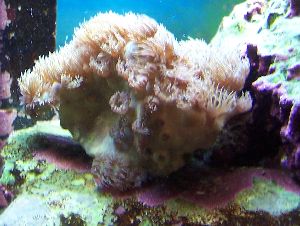
|
|
Balanophyllia hiding
7/19/18
Hi Crew!
<Hi Dani>
I rebooted my tank about 4 months ago, kept most liverock, rinsed sand bed,
added some new rock, and slowly restocked corals.
<Great>
I picked up a Balanophyllia which was opened at the store with their daylights
on. I acclimated it for about 3 hours, dripped acclimated, bathed in revive, and
placed mid-low level with mid-low flow.
It neither ate for almost a week nor extended any tentacles. I tried pellets,
Mysis, and a slurry of zooplankton even—nothing. It seemed to actually slime off
the food. So I tried a larger food like krill and shredded a piece, and laid it
on the balano. The first time it slowly—over like 20 minutes—but definitely ate
it.
<Try foods like live or defrosted brine shrimp, Mysis shrimp, and other similar
sized prey. Soaking the food in a vitamin supplement can help to ensure your
coral gets plenty of nutrients; you need to feed it at least once a day, if
needed use a turkey baster to target the food directly on the Balano without
touching it or it may not open/eat, turn off your pumps several minutes during
feeding so the food does not go elsewhere. >
So everyday I have been carefully feeding it the shredded piece of krill. Seems
to get a tiny bit faster eating each day. It pops like one tiny tentacle out now
at random times but that’s it. Do you think it is still settling in or should I
be concerned?
<As long as it is not bleaching out, you are fine here, do bear in mind this is
a difficult species to keep in captivity, it is not photosynthetic, so, as
stated it needs to be fed regularly.>
Tank is a JBJ 28,
LED 89w par intensity up to 700
2 returns @ 266 gal each
1k icecap gyre at 80% power (800 gph set at random mode, alternating flow, and
pulse [this thing is fantastic])
SG 1.025
Am 0
Nitrite 0
Nitrate <5
Alk 12
Calcium 460
Mag 1440
I feed tank everyday except water change day—2 days frozen fish eggs/Mysis and a
dose of zooplankton, the rest of the days pellets, and finally balano gets it’s
piece of krill.
I do a 25% water change weekly.
<A 10% water change weekly will be enough, less stressful and will replenish
needed additives and trace elements.>
My sandbed seems to get dirty though even with my Nassarius snails going through
it so sticking to weekly at the moment. Hoping it may stabilize where I can do
biweekly one day, want to ensure my sps and lps get more of a chance to absorb
some food from water column.
Thank you for any feedback!
<You are welcome. Wilberth>
Dani
|
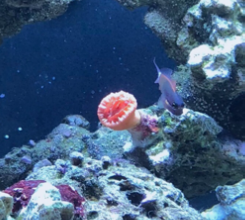
|
Re: Balanophyllia hiding
7/26/18
Happy to report that after getting it to eat more, the balano now comes out and
not just at night but during the day lighting too! ☺️
<Great! I can see that in this very nice picture>
One question on your response though that has had me really pondering—why only a
10% weekly water change?
<10% weekly is enough to keep balance without disturbing tank inhabitants and
the biofilter, “Old water” with parameters at nontoxic/safe levels is what you
should aim for.>
Pardon my ignorance, is it not better to remove as much organics possible with
each change or maybe that’s not such a concern because my tank is more balanced
now?
<As you said, it’s not a major concern on balanced systems, just keep good
maintenance practices and avoid overstocking and overfeeding>
I definitely don’t want to be stressing my aquatic friends and in fact I’d love
to cut down to maybe a larger change every other week? Or is it better with
smaller changes every week? Just curious about the logic to this if you could
please share.
<Always better to do small frequent changes, just don´t skip them>
Dani
<Wilberth>
|
.jpeg) |
|
|
Dendro Skin Receding
1/21/17
Hello WWM Crew,
<Howsit Eric?>
I have a Dendro colony and a handful of frags that came from the colony. I
noticed in the last year or so the skin of the Dendros have been very slowly
receding from the base towards the head. On a few of the frags the skin will
recede and leave a baby head behind.
<Evidence of (too much) stress>
No heads have died, the tentacles are always fully extended, and they always
eat when I feed them about once a week.
<Boing! Make that once a day>
Is the skin receding normal?
<Nope>
Attached is a picture of a few frags that have the skin receding but also
seem to be growing the skeleton taller.
Thanks,
Eric
<Do you dose Iodide-ate? I would once a week; during regular maintenance.
Bob Fenner
|
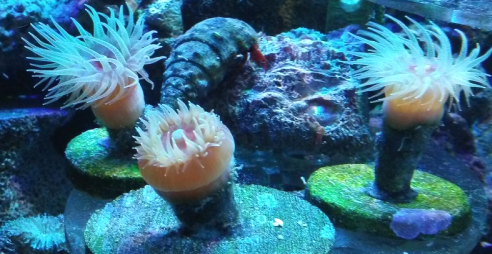 |
Duncan coral flash damage... flesh? Decapods
5/1/16
Hi first I would like to say thank you for the great information that
you provide, I am new to saltwater and all that goes with it and I get a
wealth of information from you.
<Thanks from the crew.>
I have two emerald crabs that are feasting on my corals
I have tried feeding them more so they will not munch on the coral but
their appetites seem endless so with that said I have caught them and
they are jailed in my tank until my LFS opens today in which they will
be returned and hopefully sold to someone that can appreciate them for
what they are.
<Crabs in general are opportunistic little beasts who will go
for almost anything they can (shred) and fit into their mouths.
That said they are fascinating in their own right and worthwhile. Just
be sure you know what you are getting into, but certain kinds have
particular uses as anti-algae weapons vs. "bubble" algae and so on, as
you will no doubt have read on WWM. Generally untrustworthy however.)
The emeralds have eaten a good bit of flesh off the base of my Duncan
coral, will the flesh grow back?
<A healthy colony should have little trouble recovering from
non-catastrophic damage. They are surprisingly resilient although there
are no guarantees. I wouldn't lose sleep.>
should I dip it in coral RX or Iodine mix to prevent infection or should
I just leave it alone and see what happens. Thank you again for the
great service that you provide.
Tonya
<I'd watch it, leave it alone, and see how it progresses before moving
onto disruptive treatments. If it seems to be going downhill (melting,
discoloration) then the dip might be worth looking into. A "wait and
see" approach would be my approach...should recover fine, just monitor
it, keep things clean in the system, keep it fed. Some target-fed meaty
foods will be appreciated. -Earl>
Re: Duncan coral flash damage
5/2/16
Thank you so much Earl for the information and your quick response, I
will take your advise and just keep an eye on it and I will feed it well
when it opens back up. I did enjoy the emeralds prior to them eating my
Duncan (one of my favorites) but I do still have snails and hermits and
I will try an emerald again at a later date. Thanks again
<No problem, just bear in mind that the emerald in the same tank is
likely to do the same thing. I would try it out in a different tank, or
maybe in an algae refugium.>
Re: Duncan coral flesh damage; plus notes on dips f'
6/23/16
Hi Earl,
You were kind enough to help me with a problem I was have with my Duncan
coral and I am happy to say it has fully recovered so thank you
for that:)
<Good to hear and you're welcome.>
I have been reading on wet web the last 3 nights about dip/baths because
I would like to do a freshwater/Methylene blue dip on some new fish that
I got and I feel I completely understand the process other than the type
of fresh water to use, I am confused about weather you would use RO/DI
or dechlorinated tape water as the fresh water, I know that you should
match the PH and temp but which of the two water sources is best.
<Full disclosure: first time I did a freshwater dip back in the day
(decade+) I overlooked the pH bit and it was a bad experience, although
the fish lived with us for 9 years. My point being, you're on target and
have read carefully. I would just use whatever water you normally use.
Match temp etc. to the destination environment not the transport/store
water. Dechlorinated tapwater is what I use though RO/DI is fine.
Oxygenation is also a big *must*...just a plain old "bubbler" airstone
or powerhead aimed up top is plenty. Only other tip I can give you is
that dips will sometimes freak the fish out and panic ensues, 911 and
Homeland Security are called, possibly whoever it is they send to fight
off Godzilla. Using a dark-sided container (or just the usual trusty
empty salt mix bucket we all have a heap of with a dark towel wrapped
around it) will calm things down a bit but sometimes they will try to
jump right out so be ready just in case. If you see too much distress,
end the process. EZ PZ!>
Thank you so much for your time.
Duncan Decline 4/3/16
I am a huge fan of your site. Luckily I haven't had any pressing issue
to write about recently, until now. My 65 gallon reef has a, small and
cautiously placed, mix of lps frags, xenia,
<Do see WWM re Xeniid compatibility...>
derasa clam, many motile invertebrates. My most prized inhabitant, an 8
headed green Duncan coral is not well. Overnight 3 of the heads
have begun to disintegrate, so sad my favorite coral. It
appears to be rtn which as I research appears to be mainly the term to
describe the condition but not the cause.
<Yes; tis so... akin to human "colds">
There haven't been any changes to the tank and no other corals seem
affected, yet. Are there any steps I can take to isolate the damage?
<Yes. See below>
Should I even try to frag the Duncan?
<I would not... a poor idea when soft and hard corals are challenged>
Can brown jelly disease spontaneously occur?
<Mmm; yes>
Or should I be in search of some underlying environmental cause?
<Mostly this>
I tend to maybe underfeed the tank to limit the nutrient content, could
this ever be a reaction to hunger?
<Only partly>
The tank is newer at about 10 months but with no recent (5 months)
additions. The tank specifics are 0 ammonia or nitrite, 10 ppm nitrate,
8.5 alkalinity, 400 calcium, 1.025 salinity, 78 degrees F. I will
continue to read as I eagerly await your response. Thanks so much. The
tank lights haven't come on yet so no picture but I will forward one if
you think it might offer some assistance after 8:30 am?
<I would either move the Duncan elsewhere (best) to a suitable
environment, OR remove a good deal of the Xenia (read first... the comp.
FAQs; AND utilize a good deal of GAC (carbon) and PolyFilter in your
filter flow path. Your Dendrophylliid may have other issues.... I would
also triple dose w/ iodide-ate... every three days. Bob Fenner>
Dendrophyllia Predator?
6/1/15
Good Morning,
<Buenos dias Aaron>
Over the course of several months, I have become suspicious and increasingly
convinced that I have a hitchhiker that feeds exclusively or nearly exclusively
on Dendron's and potentially sun coral. Typically, tissue is eaten from the top
of otherwise healthy polyps, and then one morning, the center will have been
consumed, leaving small amounts of tissue on the sides. Occasionally,
the skeleton leading to the center of the coral will be bored out to roughly the
size of a pea.
<A good clue>
I've occasionally seen things dart back into my Tubastrea colonies, but these
could simply be amphipods. This morning, I watched my mystery wrasse eat
something off a brand new Dendro, when I investigated more closely, I found that
tissue had been consumed.
My aquarium is a mixed reef with numerous colonies of SPS, LPS, soft, and NPS
corals. I have not witnessed any evidence of predation of any coral colony save
the Dendron's and potentially the Tubastrea. Please note these are sudden
developments, not gradual wasting from lack of food.
I appreciate any help you can provide!
Regards,
Aaron
<Well; could be quite a few groups as predators here.... a snail notably
(see WWM re Tubastrea); worms of various sorts, fishes (though they mainly feed
on compromised specimens), various crustaceans... Keep an eye out w/ a
camera that has a good lens... and send along some pix. Bob Fenner>
|
Trumpet coral 6/11/14
Would there be any reason my green trumpet coral is getting purple spots
on it?
<Quite a few possibilities... algae et al growth, nutritional
deficiencies... Have you read re Dendrophylliids on WWM?>
Could it be sting spots from a neighboring frogspawn type coral?
<Yes. Bob Fenner>
|
%20purp%20tumpet.jpeg) |
|
Saving dying Duncan? 8/8/12
Hello WWM...my name is Melissa and I have used this site extensively over
the past few months since first starting this incredible new hobby. So first
of all, I have a 29 gal Bio cube that I bought from a
friend, who had it running for just over a year. Im pretty sure I've
overstocked in my excitement, but now I have 2 ocellaris clowns ( 1 came
with the tank, the other we got as a baby and the original immediately
adopted it!) A 3 stripe damsel, yellow tail damsel,1 red fire fish, 1
scooter blenny ( dragonet?),
<Yes; both common names apply to the same fish/es>
1 cleaner shrimp, a couple snails and 4-5 small brittle stars.
Corals: 1 long tentacle plate, 1 branching hammer, few different mushrooms,
clove polyps, button polyps, green star polyps, pagoda, small open brain,
( was attached to a piece of lr I bought!) And last of all, my
Duncan coral which is the topic of my question. We got it with 3 heads and
it now has 4 baby heads. Was doing wonderful until we began
experiencing water quality issues. Nitrates went up to 80 ppm,
<Wowzah!>
now at 10 ppm. Ammonia has ranged between 0- .25 ppm, nitrite 0. Ph
continued to read on the low side, around 7.8. We added buffer and purchased
an alkalinity test and my alk was very low. KH was 3.8 and Alkalinity was
1.36. We added alkaline buffer which brought us up to KH 8.9 and alkaline
3.19. First question is could the alkalinity have caused the
declining health of my Duncan,
<Yes; as could the high NO3, allelopathy (in part stimulated by the varying
water quality) w/ some of the other "more aggressive" corals you have here>
which first the tentacles went from long and thin, to short, fat and
stubby. Next, some of them remained short and fat, while others looked flat
and deflated. We noticed that the skin on the trunk was peeling and now the
heads are pulling off the skeleton. I'd rather not remove it until all hope
is lost, but my next question is, can the baby heads be saved, considering
that they still appear healthy?
<Yes>
Their trunks are only a couple millimeters long. Should I try to cut them
off and glue them to a rock?
<I would leave them as they are currently>
And if so, can the trunks grow longer once they've been cut from the
original colony?
<They can>
Any advice would be greatly appreciated, I hate to lose the whole colony.
Thanks in advance, Melissa
<Please read here:
http://www.wetwebmedia.com/dendrodisfaqs.htm
and the linked files embedded where you find them. Bob Fenner>
|
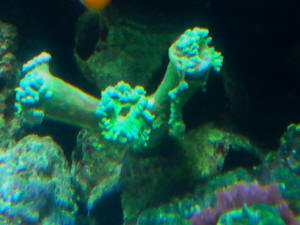 |
|
Duncan coral help please 4/15/12
Hi
<Hello Liam>
Im having problems with my Duncan corals. I picked up these two
fairly big colonies roughly two weeks ago (see picture
attached).
Do you have any ideas why they are in this state? Fairly lowish
flow area in tank. Not too high lighting area.
<Duncan (Duncanopsammia) corals can adapt to most any lighting
providing correct wavelengths are present.>
Being fed a mix of Calanus pellets, Mysis flake, Mysis shrimp,
brine shrimp and lobster eggs.
<Try holding off on feedings for a week.>
Test results are pH 8.4, Ammonia 0.001,
<Should read zero if your test kit is reading
correctly.>
Nitrite 0, Nitrate 0.25, Phosphate 0.05, KH 12, SG 1.024.
Under 6 t5 bulbs, 2 Resun 1500 pumps, 1 newave 4000lph. AquaMedic
Turboflotor 1000multi sl, TMC compact 300 calcium reactor. Tank
holds 500 litres ish with a 3ft sump.
I'm pretty sure I'm doing nothing wrong. Any ideas? I
don't want to lose them as they are stunning corals
normally.
<Mmm, any Euphylliids or Leather Corals present and near the
Duncan Coral?
May be some physical or chemical warfare going on here.>
Thanks in advance.
<You're welcome. James (Salty Dog)>
Liam
|
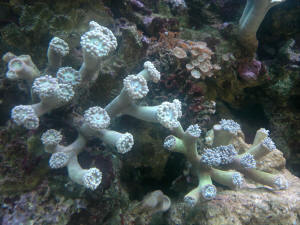 Re Duncan coral help please 4/28/12
Hello again, Thank you for your help with the Duncan coral a couple of
weeks
ago.
<Hello Liam, and you're welcome.>
I have attempted what you had suggested, by holding off the feeding for a
week or so. Unfortunately, they are still not opening anywhere near what
they should be.
I have removed a couple of leather corals that I was planning on moving
out
anyway and they are no where near my Euphyllia corals. I get the Ammonia
at
0.001 as I use a Seneye reef testing dongle. I have double checked with
an
API drop test at home and a Salifert test kit in work and they both give
me
a 0 reading. I have struggled to keep hard corals for a long long time
now,
and can not figure out why. Please help in anyway you can. I am tearing
my
hear out trying to keep hard corals alive, sps in particular.
<First off, the Duncan Coral (Duncanopsammia axifuga) is not a stony
coral <<? It is indeed... a Dendrophylliid. RMF>>and this coral prefers to attach to solid objects in soft, sandy areas.
Not
in the sand mind you but on solid objects on the sand bed. Under
optimal
water and lighting conditions they readily propagate and generally form
a
continuous mat of tentacles that conceal the overall shape of the
underlying colony. If your coral is on a frag plug, carefully cut
away
unneeded material from the plug and super glue (gel type super glue) to
a
rock near the substrate, preferably in a lower flow area. Learn
more about
this large family of corals here.
http://www.wetwebmedia.com/dendrophylliidae.htm
And do read here.
http://www.wetwebmedia.com/corllgtg.htm
http://www.wetwebmedia.com/growingcorals.htm>
Thanks again.
<You're welcome. James (Salty Dog)>
Liam
|
Duncan Coral heads popping off
8/15/11
Hello, I tried searching both WWM and the internet but really not
finding any information.
<Ok...>
About 4-5 months ago I purchased some frags of Australian Duncans. It
was 6 heads that were actually fragged into a 4 head and 2 head
frags.
Since, I brought them home, I notice that there had been zero growth
and that I had lost a few heads leaving just a crater in the tube that
the head attaches to. I thought something was eating them.
<Mmmm>
I moved them around and spot feed and had really seen the heads grow
nice and bug and fat, but still not producing any new growth.
<What is near this Dendrophylliid? In the same system?>
Well two days ago I noticed that the four headed frag was down to two
heads, At first I again thought something was getting them but this
morning, I noticed that the head was just popping off all by
itself.
When I turned the lights on the heads were closed as normal and as they
came out one of them just popped off slowly. that head and the one I
lost the other day I noticed just floating around the tank.
I am wondering what might be happening to my Duncans?
<... what you describe... Need more, useful information.
Particularly list of tankmates>
All other coral in my tank are happy and healthy and
have no signs of trouble. I checked to make sure no other coral was
touching or could touch the Duncan with tentacles.
<Don't have to touch>
I had just had a complete water check done at the LFS all was good.
<... data, not opinions>
I am running a 29g and a 10g, 29g had the 4 head and
the 10g had the 2 head. I noticed this happen in 10g first.
<These small systems are problematical... too hard to keep
optimized, stable>
With tank size, I do water changes weekly and change filters often.
I have a normal clean up crew consisting of snails, blue leg and
scarlet hermits
<Not a fan>
In the 29g I have a clown, 2 Chromis, 2 Banggai cardinals and a scooter
blenny 10g is a bow tie damsel and some cleaners lighting on the 29g is
2x30" t5 10k white and actinic and a 12' panorama led lighting
on 10g are 2 x 15 watt pc bulbs.
I guess id like to know why I saw no growth and now why the heads are
popping off.
<Most likely allelopathy... secondly water quality issue/s>
Also are the heads the living part of the coral and need to be feed or
is the tube they are attached part of their body.
<? See WWM re foods/feeding/nutrition for the family>
the two heads floating in the tank are they dead or should I place them
someplace?
<? Read here: http://wetwebmedia.com/CorlCompArt.htm
and the linked files above... the family's compatibility... Bob
Fenner>
Thanks
Steve
|
Tubastrea Cost/ Toadstool Mushroom Help
7/18/11
Hello,
I'd first like to thank you for all you guys do on this
website. I've learned a lot over the years from browsing
through your articles. I have a question of mine own now.
I've attached a picture of a coral I believe to be a yellow
tube coral, Tubastrea sp.
<Is a Dendrophylliid of this genus>
If I am wrong please tell me what it is. It acts and looks like a
yellow tube coral when feeding (I feed it vitamin enriched
mysis shrimp every other day, making sure each <polyp> gets
some), but it looks a little different then the pictures I've
seen of any, when the heads/polyps (sorry I don't know what
they are called) are closed. The head/polyps are growing from a
hard skeleton, while the versions I've seen online seem to be
mostly fleshy.
<More so than this specimen, yes>
I've been attempting to nurse it back to health after a
friend couldn't take care of it properly. Does it look this
way since it is still sickly?
<Mmm, yes... famished>
Either way, it's getting a bit much for my 14 gallon Oceanic
Biocube (the protein skimmer is sure getting it's money worth
of work) and my lfs has offered to buy/frag some of the heads for
me. Like I said, I got the coral from a friend so I have no idea
how much I should be selling it for. About how much would one
head/polyp cost?
<A dollar in trade is about right for something of this
nature>
I've checked liveaquaria.com but they sell by 'small,
medium, large', so they aren't much help at the
moment.
Also my toadstool mushroom has been looking sick after a past
incident (I left the tank in the care of my mother while I was in
college, and the lighting times were messed up, the water was
rarely changed, and God only knows if the supplements were put
in. I lost a huge Kenya tree coral, some purple mushrooms, and
half of my 'Mary Jane Zoanthids', which I hear are rare
to begin with). The toadstool looks dead to be more precise.
<What does the air above the tank smell like? I would remove
this soft coral, and most of the water; replace the latter with
new>
It appears to be bleached (it's white) but half of it opens
slightly. It's only about 1/3 of an inch. I've had it for
about 3 years (since I first set up my tank). I've been
trying to nurse it back to health for about a month and it
hasn't been working. I believe everything in the tank's
chemistry is fine, since I have other corals that are reproducing
and are looking well.
<Hard to do in such small volumes>
I do a 20% water change once a month,
<I'd do this every week>
SeaChem's marine buffer to keep the pH at 8.3 biweekly, add
Sera marine trace elements components 3 and 4 weekly, and some
bioenzymes (bacteria that claim to help nitrate levels). Is the
mushroom a lost cause? Or am I doing something wrong?
<Read here: http://wetwebmedia.com/CorlCompArt.htm
and the linked files above>
There are no fish in the tank, a peppermint shrimp, 2 snails, and
4 blue legged hermit crabs. I feel that if something was wrong
with the water the invertebrates would be showing signs of
struggle.
<Agreed... this is likely a situation of Cnidarian
allelopathy... can be rectified in time>
Thank you very much,
Justin
<Welcome. Bob Fenner>
|
|
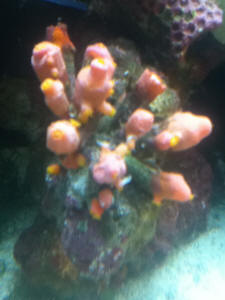
|
|
Re: Tubastrea Cost/ Toadstool Mushroom
Help 7/19/11
Hi Bob,
Thank you for all the help. I am a bit confused though. Did you
mean each Tubastrea polyp would be worth $1?
<Yes, thereabouts>
Also, I will try my best to revive this poor thing before I do
anything to it.
<A VERY good idea. Cutting it up currently will not likely
work>
Thanks again.
~Justin
<Welcome. BobF>
|
|
Pagoda Cup question
6/27/11
Greetings WWM
<Hi there Eric>
I'm hoping you can provide some advice regarding a pagoda cup
coral.
<Ok>
I purchased a Pagoda Cup from LFS about 3 weeks ago that has yet
to extend polyps. As you can see from the picture I (hopefully)
included, the coral is in the middle to upper third of the tank
on the left side, indirect but good flow (no detritus
accumulation) and strong lighting . I thought I should note that
when I introduced the Pagoda (drip acclimation for about 1.5
hours), the Sun coral on the right side of the tank stopped
opening for about 2 weeks.
<A good clue>
A few days ago it started opening again, but the Pagoda remains
closed. While the polyps have yet to open, the coral's tissue
looks good/unchanged since introduction. Also, I had a small
Pagoda Frag almost in the same spot the new one is in (slightly
lower), but it fell into the LTA in the corner and was killed.
Before it died, it was thriving, opening daily and growing fast.
I've been back to the LFS, where the other Pagoda's in
stock look great.
Tank stats: 55 gallon plus 30 gallon sump with refugium (holding
macro algae), Coralife protein skimmer, and phosphate reactor;
Lighting: Nova Extreme Pro fixture running 6 T5's, 3 54 watt
460nm Actinic Blue (on 12 hours) and 3 54 watt 10,000K daylight
(on 8 hours), modified with 4 LED moonlights (off for 6 hours); 2
Wavemaker powerheads, plus 3rd powerhead in back right corner and
return in far left; water parameters: (from Oceanmaster kit)
Ammonia and Nitrite are zero, little nitrate (the kit's
minimum show is 10), ph 8.1,; (from Red Sea master test kits)
Calcium 450, Magnesium 1380, phosphates .36; temp 79, salinity
1.026. I'm not sure why I continue to have phosphate in the
tank even though I've been running Phosban in the reactor,
and placing polyfiber in the path of water entering sump. I also
keep Chemipure and Ammocarb in the sump to help with
'chemical warfare' issues.
<Good. I think this is likely the issue here still>
No algae problems, fish are thriving, all other corals doing
great except for purple SPS (bird of paradise) top center which
receded greatly a few weeks ago; dipped it in Revive coral dip,
which slowed down its decline (but it is still slowly dying).
Thanks in advance for your assistance.
Eric
<I suspect first, the Goniopora to the lower right of the
Pagoda... Would add a good dose of iodine/ide, spiff up the RedOx
here in what ways you can... and keep offering some food every
other day. Bob Fenner>
|
|
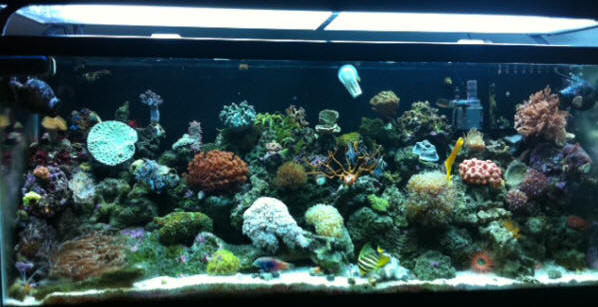
|
Re: Pagoda Cup question
6/27/11
Thanks Bob for the prompt reply. A few follow up questions: I add
one drop of iodine to the tank 3-4 x per week. Should I still add a
healthy dose, and if so, how much?
<About twice the dosing rate on the product>
Also, any tips for speeding up the RedOx?
<Please read here: http://wetwebmedia.com/redox.htm
and the linked files above>
I'm not sure I know exactly what that means. And do you not
view the phosphate level as a problem?
<Not likely, no>
I'd love to stop fretting about it. Finally, I'm convinced
that my tank is too crowded, but I'm moving cross country in a
year and am hoping to wait till then to upgrade to a significantly
larger system. From the picture I attached, do you have any
thoughts as to whether an upgrade can wait?
<You have some questionable organisms... the LTA and what
appears to be a Cerianthus at lower right...>
I had figured all my small frags would have grown slowly, but to my
surprise they've spread very quickly.
Thanks again. You and your team are truly amazing.
Best,
Eric
<Welcome. BobF> |
|
Pagoda Cup Trouble 6/6/11
Hello,
<Hi there>
We have a quick question about a Pagoda Cup we bought quite a
while ago, probably about a year back now. We have never had a
problem, it has always had extended open polyps and has been
great during feedings. A few days ago, we noticed the right edge
had a bit of white tissue. Today this seems to have spread and
some of the polyps are heavily receded or are completely dead. In
addition, some of the polyps farther back from the edge have
white areas around the base. Even though they are extended, we
are sure this is a bad sign. We've sent some pictures in
hopes that we can solve this as soon as possible. We have a track
record of rapidly declining corals once an issue presents itself
though this has not happened lately.
<Mmm, the history... a pattern I'm/you're looking
for...>
No parameters or lighting have changed. We do weekly 30 gallon
water changes in the 90 gallon tank. We did have a recent
outbreak of flatworms, but after dipping
<With what?>
and siphoning with a syringe the problem seems to be under
control. During that time, the Pagoda (and the other corals)
never seemed affected.
<There's often a lag time...>
Do you have any suggestions?
Thank you,
D
<Need to know more re your system, maintenance practices
(supplements, chemical filtrant use, chemical measures,
foods/feeding) and related gear if any. Bob Fenner>
|
|
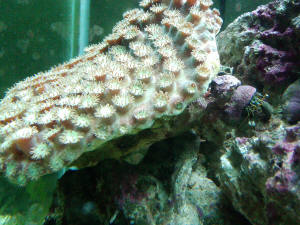
|
|
Re: Pagoda Cup Trouble 6/12/2011
Hi Bob,
Our apologies for a delayed response. We dipped the flatworm
infected pieces in Reef Dip Coral Disinfectant by Seachem
(recommended by our LFS) and this worked very well. Within the
hour the corals were expanded again with no issues. The problem
has been resolved since then.
<Ah good>
We have a 90 gallon Aqueon MegaFlow tank with T5 6 pack Aquatic
Life stock bulbs (3 whites/3 actinics). We also have an Aqueon
Proflex sump set up as a refugium and a Sealife Systems Impact
protein skimmer. Parameters are normal (Salinity 1.024, pH 8.3,
Nitrite/Nitrate 0,
<Need some of the latter; otherwise can be
rate-limiting>
Calcium 500,
<A bit high. I'd keep twixt 400-450 ppm>
Ammonia 0, Alkalinity 8,Temperature 79-80)
The fish are fed twice daily with garlic marine pellets and
mysis, the corals are fed twice weekly with H20 coral food and
marine snow,
<This last is a placebo; of very low nutritive value>
and the anemone is fed twice weekly with shrimp.
<I'd expand this diet... see WWM re>
We don't use any supplements or chemical filtrants, but we do
use Instant Ocean Reef Crystals and RO water for water changes.
Since our last email, all of the other corals continue to be
normal except the Pagoda Cup. The white tissue is progressing and
now some of the larger polyps along the right edge are wilting
and barely expanded. We are mostly sure that this is not a
problem caused by the fish, there have been no livestock changes
in months and again we've never had a problem with this
particular coral.
<Mmm, can/could be something very small... a Nudibranch, worm,
crustacean... Or just nutrient lack>
If needed, livestock is as follows:
False Percula, PJ Cardinal, Magnificent Rabbitfish, Kole Tang,
Sailfin Tang, Hippo Tang, Bluejaw Trigger
Thanks for your help,
D
<Have/had we gone over, referred to you the archives on
Dendrophylliids on WWM? I'd be perusing those files. Bob
Fenner>
|
|
Please help identify Yellow "Growth" on Sun
Coral 5/8/11
Hi,
<Hello Brian>
I have several Sun Corals one of which has developed a yellow
growth over it's surface over the last few days.
<I see this...>
The sun coral is not opening up well in the area affected.
I have been to my local stores where I purchase coral with
pictures however, they could not identify what this is.
Suggestions made have been either a fungus, a sponge, or a
secretion from the sun coral itself.
<The latter almost assuredly. I thought/feared this might be
some sort of matter "left over" from
Wendletrap/Epitonium reproduction, but am now thinking
"something" disturbed these polyps sufficiently for
them to "throw up" their mesenterial filaments>
If you could help identify and suggest a course of treatment it
would be greatly appreciated.
<Seek out the source/pattern of the upset. Another Cnidarian
perhaps? Do you have an errant Anemone in this system? Did
someone drop a dry "supplement" of some sort on this
area? No "treatment" advised. Bob Fenner>
Thank You Brian Hunter
|
|
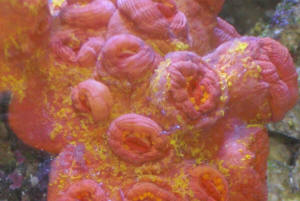 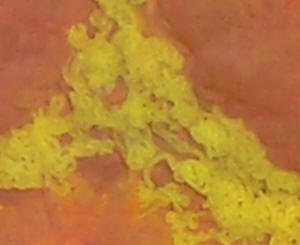
|
|
Re: Please help identify Yellow "Growth" on
Sun Coral 5/9/11
Thank You,
<Welcome>
I did finally come across another photo which looked exactly like
mine did. It was posted to a forum for help. Several answers came
back that it was perfectly normal and that they believed it was
related to overeating by the sun coral.
Brian Hunter
<Mmm, well, I don't think it's "lethal
behavior", but is not "normal"...
i.e. I've never encountered this on the many occasions of
observing Tubastrea spp. in the wild. Cheers, BobF>
|
Duncan's coral not opening 4/26/10
Hello Crew,
<Wayne>
I have a Duncan's coral with about 30 heads on the colony which I
have had for about a year. It has been sitting in it's current
location for several months now and it has been opening up quite large,
extending it's tendrils and eating well. About a week ago it
stopped opening as fully and opened less each day until it is finally
not opening at all. The nearest corals are about 6-8 inches away (some
Xenia, Green Star Polyps, Green Sinularia)
<These can/will "all do it">
and there are some Zoanthids at least 12 inches away.
<Ditto>
I have not added any new corals for over 8 months. I am doing regular
water changes and all my other corals are quite happy. The only thing
that comes to mind is that I have not replaced my T5 bulbs in over 6
months and perhaps their light output has shifted. My alkalinity is at
3 mEq/L and pH is about 8.2.
Ammonia is zero, phosphates are not detectable, calcium is about 400
mg/L.
I have not tested for Mg. I did however start adding Purple Up about
every 3 days at the recommended rate a few weeks ago. Would you be able
to suggest some other possible causes which may be aggravating my
Duncan's
colony?
<It's the big loser here... Read: http://wetwebmedia.com/cnidcompppt.htm
and the linked files above, and onto Dendrophylliid Comp. FAQs... There
are a few techniques that may save this colony... else, I'd be
moving it some place different... another system. Bob Fenner>
Thank you and best regards,
Wayne
Re: Dendrophyllia help 1/7/10
Thank you for the possible explanations and potential solutions.
I moved the Dendrophyllia to another tank as you suggested. The new
tank has more volume, far fewer corals and more flow that the tank the
Dendro originally was in but I don't believe overly strong. I did
the same with a leather coral which closed up for about a half week
before I moved it which made me think that your theory of allelopathy
was what was happening to these specimens. After a few days, both
corals opened up again and I was thinking all was well.
<I see>
The leather continues to be doing well. The Dendro is another
story.
First, it has stopped "eating". Any food I drop into the
individual polyps are not ingested. The food eventually falls off of
the polyps as if the nematocysts are not working.
<Not atypical with this genus, other closely related genera of
Nephtheids in captivity unfortunately>
The series of events seem to be:
1. the tentacles of the polyps seem to be taking on a more full rounded
appearance corresponding to loss of the "stickiness" of the
tentacles and cessation of eating
2. after a few more days the entire polyp appears "bloated"
with the tissue taking a plumped appearance where it attaches to the
sides of the corallite cup
3. one polyp actually had this bloated appearance manifest further to
actually having two distinct raised lumps (seemingly full of fluid)
where the polyp attached to the outside of the corallite cup. I thought
the lumps might have been the polyp reproducing asexually but the lumps
subsequently disappeared
4. the polyps tentacles stop retracting and the polyp takes on a closed
appearance at times with the mouth remaining open
5. the tissue where the polyp attaches to the outside of the corallite
cup starts deteriorating and releases from the skeleton
6. the polyp eventually detaches from the skeleton completely and falls
out of the cup detaching completely from the skeleton
<All very bad signs>
When the Dendro was in the original tank with the higher concentration
of corals, the process I described above was very fast and might have
taken just a couple of days. Now that the Dendro is in the new tank,
the process
has slowed and might take a week or week and a half.
Any other suggestions that you could provide?? I hate watching this
once beautiful, growing coral head slowly die, polyp by polyp.
<There are some folks who have had a modicum of success with keeping
this genus... I have not. You might search for Charles Delbeek's
article/relating of experience... on the Net. Bob Fenner>
Re: Dendrophyllia help 1/8/10
I think there might be a confusion. The coral which I have is
Dendrophyllia (similar to Tubastrea).
<Ahh, sorry re my confusion here>
From your comments and your suggestion to look at Charles Delbeek's
reference, I think you believe I have a Dendronephthya (or Carnation
coral). If this is the case, what would be your advice to my dilemma
for my Dendrophyllia?
Thanks!!
<Please read here: http://wetwebmedia.com/dendrodisfaqs.htm
and the linked files above. Bob Fenner>
Dendrophyllia help 12/30/09
I have doing pretty good with a species of Dendrophyllia for the last
couple of years. It started off with just one polyp and had reproduced
into a coral head of about 25 polyps.
<Nice>
A month or so ago, I noticed one of the polyps seeming to
"pour" out of its individual corallite cup. Not knowing what
was going on, I let it go on thinking it might be a form or
reproduction.
<Mmm>
In another day or so, the polyp was dead and the corallite cup that it
had occupied left empty. Then, the next day I noticed another polyp not
extending as fully as it did before.
Within a couple of days, the inside of the polyp (mesenteries, etc.)
was mysteriously gone and all that remained was the polyp tissue (oral
disc and mouth) surrounding the opening of the cup which subsequently
released from the skeleton again leaving an empty cup.
Since then, I have tried dipping the entire head in iodine baths,
Melafix baths,
<I would NOT do this>
freshwater dips, using Flatworm Exit (suspecting flatworms)- the
kitchen sink! With the death of each subsequent polyp, I used sharp
scissors to cut off the empty cup thinking that perhaps whatever the
bug or disease that had killed that polyp would be cut out.
<Is systemic... the root cause is your display... something re water
quality... Do you have another established system to move this colony
to?>
A few weeks ago, I thought that everything was under control as no more
polyps died and the ones left alive were opening up, ate and even
started budding small polyps.
Then yesterday, another polyp died and it seemed that everything is
starting to go south again.
I checked all water parameters (pH, nitrate, calcium, phosphate, etc.
etc.)
and everything seems perfect.
<There is/are a huge number of qualities there are no colorimetric
assays for>
On top of this, all of the other corals are doing well (leather,
Scolymia, Blastomussa, Micromussa, Acan, Dendroneptheas,
Scleronephthya, xenias, Zoanthids, mushrooms, etc.). Also, I have what
my LFS calls "microdendrophyllias" which are very small
versions of the ailing Dendros and they are also doing well.
Any advice? Help? I would appreciate anyone's insights as I am at
this point stymied of what to do next. Thanks!!
<The easiest, though far-from satisfying possibility here is
"allelopathy"... Some one/group of other Cnidarian life
winning out over the Dendrophyllia... there are a few approaches to
limiting the effects of this sort of warfare... but the quickest, most
assured is moving the "loser". Please read:
http://wetwebmedia.com/cnidcompppt.htm
and the linked files above. Bob Fenner>
|
Algae growth on Dendro 6-15-2009
Hello. I have a beautiful Dendro
<... the stony coral Dendrophyllia...>
that I bought a few months ago. I bought one head, and 4 baby
heads have sprouted since I bought it. It's been doing great
and I do feed it once or twice a week.
<Mmm, I'd kick this up a bit... See WWM re the
family>
I just noticed though, some type of dark brown algae growing on
the back half of the base of the Dendro.
<A bad sign>
It seems to be close to the main head, but not growing over it
yet. I don't see that algae on any of the surrounding rock or
anywhere else in the tank. It looks smooth and almost like a
sponge growth. I don't have a picture of the algae, but here
is a picture
of the Dendro I took a couple months ago. Are Dendros susceptible
to algae or some other type of growth?
<... just when their health is impaired>
Thanks! Pam
http://i203.photobucket.com/albums/aa157/matsis1234/DendroNewCamera.jpg
<Welcome. Bob Fenner>
|
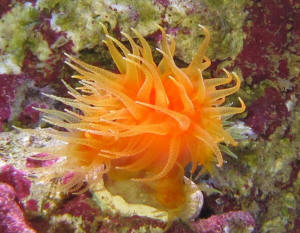 |
|
More info - Algae growth on Dendro
6-15-2009
Hello. Thought I should include a little more info about my set
up and tank parameters. I have a large Duncan colony and a Sun
Coral, and I do not see the dark brown/black growth on those
corals or any other corals in my tank, nor do I see it on any
rock. It seems to be isolated to the Dendro. My tank is just over
two years old. I can try to get a picture of the algae on the
Dendro, but it might be tough because it's on the back half
of the coral (base of the coral only, not the heads). My tank set
up and parameters are:
53 gallon display with 10 gallon sump / Elos skimmer rated for
150 gallons
10% bi-weekly water changes with Coral Life Salt
150 MH bulb and 4 24w T5 bulbs. Replaced all bulbs about 2 weeks
ago, and raised the light fixture an inch or two after changing
the bulbs.
Salinity 1.025
Temp -79-81
Nitrates: 5-10
Phosphates - Not sure, but I do run Phosban in a Two Little
Fishies reactor and changed it out about a month ago
<... I wouldn't... again, please follow directions and
search, read before writing us... BobF>
Alk 7
PH 8.3 lights on / 8.1 lights off
Calcium 350
Mag 1170
Algae growth on Dendro - Not Algae after all.
6-15-2009
Thanks Bob. I will increase the feedings. I pulled out the Dendro
last night and put it in a little bowl of tank water, to try and
see if I could scrape off the algae.
<I would not do this>
I found that it's not algae at all. It's the skeleton
turning black.
The heads look totally healthy, and it eats really well when I
feed it, and captures some food on its own. Is the black skeleton
a sign of disease, or a sign of starvation?
<Perhaps neither... maybe allelopathy, losing to one of the
other species/Cnidarians... perhaps just a "blem"... of
transient nature... Do search, read re the former on WWM>
Could underfeeding it cause this? Should I be feeding it every
day or every other day instead of 1-2 times a week?
<Yes... t'were it me... again... just read re the
family...>
I did read through the Dendro FAQ on WWM, and didn't find
anything that appeared to be related.
<Oh...>
Thanks!
Pam
<Perhaps a bit of iodine/ide, time going by... B>
Re: Algae growth on Dendro - Not Algae after all. Nor
reading... 5/16/09
Thanks B. I'll take your suggestions and research
allelopathy. I have mostly LPS in my tank so I thought I was
pretty safe from allelopathy....
<... indeed, NOT immune>
I have a good sized Frogspawn, Hammer,
<Very stinging... near and distal>
Duncan, Sun Coral, Small Acan. No SPS, and only one small colony
of zoo's
<Can be very toxic...>
and nothing else for softies. The Dendro was close the sun coral
and about 5" from the Frogspawn. I moved it to the far side
of the tank last night, away from the Frogspawn.
<Good... again... stop writing, start reading in earnest.
B>
Thanks for the help.
Pam
|
Re: Goniopora Worms. Now Dendrophylliid beh./hlth.
05/27/09
Lynn,
<She's asked that one other of us resp. here>
OK - one last question and I promise I will leave you alone!
<No worries>
I have a beautiful Pagoda Coral. It is one of the corals that I have
had the longest and it has thrived in it's current location. All of
the polyps (I believe that is what they are called) open daily and are
beautiful - deep brown with a green "eye" in the center.
Yesterday, one of the polyps did not open and it appears to either be
encased in a clear bubble, or have a clear bubble on the side. None the
less, it did not open yesterday and has not opened today. Tons of light
- good water quality - good calcium level - good water flow. Any ideas
what the issue could be?
<Mmm, might have gotten "stung" by something... other
animals can release tissues... Or bitten by a fish... or maybe just a
good bit of sand/grit got into it. I would not panic. Most likely
self-healing. Bob Fenner>
Thanks so much!
Brian Duncan coral stung help!!!
4/14/2009
Hi crew!
<Tyson>
I hope things are well on your end. My Duncan coral became unglued to
its base yesterday and landed on an Acanthastrea echinata.
<Yikes!>
The Acan is unscathed, but the Duncan was badly stung. Three heads on a
roughly 20 head colony are encased in mucus and the thin tissue around
the skeleton attached to these heads has disintegrated. I am making an
assumption that the 'mucus' is necrotic tissue
<Mmm, not necessarily. Can/could be as you state... mucus, a
reaction series from the Mussid contact>
and I've been periodically (and gently) trying to remove it with a
small pipette.
<I would not do this>
Is there any course of action that you can recommend? I've grown
this colony from a single head and am very concerned for it.
Thanks a ton,
Tyson
<If you have a sump/refugium, other similar, very-stable place to
put this colony, I would, and treat the water with an iodine/ide
solution (Lugol's if this is what you have). Only time can/will
tell how much real damage has been done here. In the meanwhile,
isolating the Duncanopsammia will help it to heal w/o being predated.
Bob Fenner>
Re: Duncan coral, hlth. -- 4/30/09
Hi there,
<Howsit?>
I wrote a few weeks ago with concerns of a Duncan coral that had fallen
on an Echinata and suffered a severe sting. About one quarter of the
large colony was necrotic and there was severe tissue recession. I am
happy to report that the coral has made a full recovery and has even
shown signs of new polyp development. Thanks again!
Tyson
<Yay! Congrats on the recovery and thank you for this update.
BobF>
Help broken Dendro -- 03/22/09
Hi Crew,
<Hi Rachel, BrianG here,>
I am hoping that you can help. I purchased a "Dendro"
<Dendrophyllia californica. I presume> I placed it in my tank,
fully opened and is beautiful, felt it was worth every bloody cent that
I paid for it,
<They are worth every penny and magnificent looking.>
however my black clowns were picking at it, so I decided to move
it....bad decision on my part, as
when I pulled it from the tank, I went to set it down on the counter to
move the rock underneath the "Dendro "and it dropped on the
floor, and one side of the large head cracked <Oops!>. Is it
doomed, is there anything I can do to help him, beside kick myself?
<Don't kick yourself yet, you should be fine. I cut Dendro's
all the time and sometimes cut wrong and slice into the skeleton. They
are pretty resilient and usually heal up quite well. Search this site
for "Dendrophyllia" for care and feeding
suggestions..>
I took every ounce of me to purchase him, as he was the most I have
ever spent on a coral, Please help?
<Good luck with your new coral!!!>
By the way, I love your site....
thanks
Rachel
|
Tubastrea tissue receding 01/16/09 Hello, I
have a Tubastrea coral that I purchased about six weeks ago in my
265 gal. tank. I placed it in an area with dim lighting that I
can gain access to for feeding. It is on top of a rock on the
floor of my aquarium under a rock ledge (see photo). When I first
purchased this coral, the polyps were not extending and so it
took several days of blowing Cyclop-eeze over them before they
started coming out. <This is normal. Sometimes they take even
longer to start feeding in a new tank.> The polyps would
extend more and more each day and I took a picture of the coral
one night when all of the polyps were extended. Once the polyps
started extending completely, I changed the diet to chopped
pieces of krill and hand-fed each polyp that I could and squirted
Cyclop-eeze on it to feed any polyps I may have missed. I feed
every other day. <Good work!> The coral was flourishing. A
couple of days ago, I noticed the tissue on one of the tubes
seemed to be receding (see photo); I wasn't certain at first,
but the next day, the tube was completely hollow. This morning,
it looks like the tissue on the tube directly in front of it is
starting to recede as well (I haven't had a chance to take a
photo of this yet). The yellow blob that you see on the coral is
some sort of sponge and it was attached to the coral when I
purchased it, but it was more on the side of the coral and has
just recently moved to the top. I check the levels of nitrites,
nitrates, ammonia, calcium and pH on a regular basis and I add
iodine once a week. I have researched your website looking for
clues on what could be the reason for this and I see a common
theme of possible starvation. I have read on other websites that
once the tissue has started to recede in a tube, algae can grow
inside and start a chain reaction of recession in the rest of the
tubes. I really thought that I was feeding frequently enough.
<You are.> Is the solution to this simply more feeding or
do you think I have another problem? Is the sponge possibly doing
any damage? <Not a sponge... as you note in your follow-up,
looks like Wendletrap snail.> Please help, I hate seeing what
was once a thriving coral wasting away one tube at a time.
Thanks, Susan ---- To Whom It May Concern: I submitted this
earlier today and have since then found out that the
"sponge" is, in fact, a Wendletrap snail, which I have
read is a threat to my Tubastrea. So, I have removed it. Is there
anything else I need to do to my coral in addition to physically
removing it with tongs? <If the snail is now gone, I think the
coral will recover. You might want to increase water flow to the
area if possible... to help keep algae from growing (and debris
collecting) on the exposed skeleton.> Please help. <Keep up
the good work. :-) > Thanks,
Susan
<De nada,
Sara M.>
|
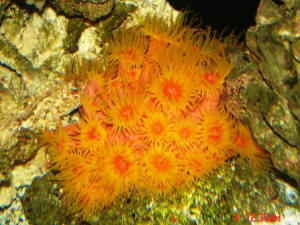 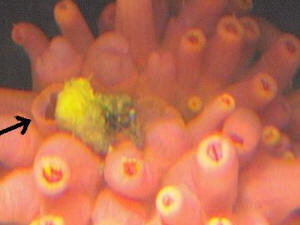 |
Duncanopsammia HELP!! 10/9/08 Hi all you
geniuses!! <Mmmm, not I> I am looking for some insight and after
searching endlessly I have, again, found myself at your feet. Ok here
it is: I had purchased a Duncanopsammia frag of 2 heads, which within 2
months has turned into 8 heads. Then, like a week ago, the polyps
stopped opening up, for no apparent reason. I am sure there IS a
reason, but I cant seem to find it. I have a mixed reef, <Mmm,
perhaps this is "it"> with a couple sps frags, and mostly
LPS, but nothing else seems to be bothered, everything is opening and
extending just fine. <So... not due to some deficiency, food, water
quality-wise> They did open up for a couple days, but not as large
as they have been up until recently. My methods of compassion so to
speak have been, moving them higher, moving them lower, moving them
into more flow, less flow, shade, no shade, and nothing seems to
matter. I did make a slight change in lighting when this started, but I
can't tell you if it was before or after the Duncan problem. I have
a 2x250 watt HQI with 4x65 watt actinic supp. and I changed the
actinics to 50/50 because that was all I had, but then today have
changed them back to the old bulbs to see if this made a difference in
the Duncanopsammias extensions. But unfortunately, it did not, and they
are still shriveled up to a belly button look alike. Any help would be
so much appreciated! Oh and I do regular water changes of 10-15%
weekly, and 20-15% monthly... Thank you in advance!! Tanya PS please
use email XXXX address for replies, I use that one more frequently.
<Most likely is a case of allelopathy if as you state, other
Cnidarians appear fine. I would move this colony elsewhere in the short
haul, re-acclimate it here if you'd like through the methods
mentioned here: http://wetwebmedia.com/cnidcompppt.htm and the linked
files above. Bob Fenner>
Re: Duncanopsammia HELP!! 10/12/08 Hi Bob! I
just wanted to say thank you for saving my Duncans! You were right, and
I found the culprit. I had the Duncan mini colony about 6 inches away
from a colt coral, and it had been there since I got it, and so it
didn't dawn on me that it would all of a sudden be attacked, and so
when I got your email, I inspected the area and moved the
Duncanopsammia to the other side of the tank, it was far left, so I
moved it far right. The very next day, it was open. <Ahh!> I had
also moved a small toadstool closer to it (again, about 6 inches) and
that is when it started acting weird, so it could have been either the
colt or the stool. In any case, the outcome is great, and your awesome
advice worked!! Thanks so much! Tanya <Welcome my friend.
BobF>
Ailing Pagoda and angry Perculas 10/8/08
Hello! <Hi> I have a small 8 gallon BioCube at my office with
some live rock, mushrooms, anthelia, polyps, and a pagoda cup coral. I
have 2 false percula clowns, a neon goby and a yellow watchman goby.
<That is too much life for such a small tank.> My tank has been
up and running for about 1 1/2 years now with all the same fish and
corals. Recently, my pH became very low (7.4) despite weekly water
changes, and adding buffer. Out of desperation (my first mistake) I
purchased a buffering powder that after adding 1/2 of a packet would
miraculously adjust my pH to 8.2. Yeah, right. As soon as I added it,
my pagoda seemed to shrink before my eyes! <Probably pH shock.>
It's polyps retracted and it stayed like this for about a week. I
was sure I killed it, however it is opening up again although the
polyps are smaller? It's just not the same! So my first question
is, what did I do and can it be remedied? <You most likely raised
the pH too fast, not much can be done now except maintain good water
quality.> My second problem is related to the percula clowns. They
made their home in the pagoda cup and guarded it if I tried to get near
it. I removed the pagoda to put it in a 58 gal we have at home in order
to try to nurse it along. They are ANGRY!!! The female is attacking
other corals in the tank now and is not a happy camper. <Is looking
for a new home.> I didn't know if I should try to replace the
pagoda with another coral in hopes that they might take to it, or if
once they have a home they never adapt to another one? <Can find a
new home if they find something to their liking.> Do I put the
pagoda back in the tank and see if it recovers? <I would leave it in
the more stable larger tank.> Another tidbit... I tested the 8 gal.
and figured out the calcium levels were too high which was causing the
low pH. I have since gotten the parameters back to normal. <Good,
but the inherent problem of small tanks, parameters can change
radically quickly in small water volumes.> Thanks for your tips!
Wendy
<Welcome>
<Chris>
dying pagoda coral...i don't want to lose it
-09/09/08 my pagoda is a dome shape not a cup shape, very
green and pretty and i heard domed shaped is rare. <Uh, no, not
rare. These animals change shape as they grow. They only start out
in the cup shape, then grow out of it.> i have had it 3 years. i
noticed it had a dead spot in the middle last week, no big deal
happened before and went away...this time, it got bigger. i did a
30% water change, next day added Chemi pure, and i recently
replaced an old filter (put old bio media in it and fresh carbon)
and replaced a bulb and got a new power head....now its more dead
with more holes in the tissue between the polyps. I tried moving
it, damage is still being seen all the polyps open just fine but
the green between them is rapidly disappearing don't want to
lose this coral, it is my favorite one! <Ok, firstly I need to
know your water parameters (temp, salinity, etc.). Without knowing
those, the most I can tell you is that this looks like either 1)
sediment damage resulting from inadequate water flow, or, 2)
it's starving to death (resulting from inadequate feeding)...
or both.> i attached a photo of it (taken after lights out) the
spots not covered in algae are new and the white spots just
appeared today <Yikes... please slow down. Sometimes when our
corals get sick we do too much all at once trying to save it and
just end up stressing the coral out. Please do write back with your
water parameters. In the mean time the only thing I would suggest
you do is perhaps increase the water flow over the coral (but not
too much). Best,
Sara M.> |
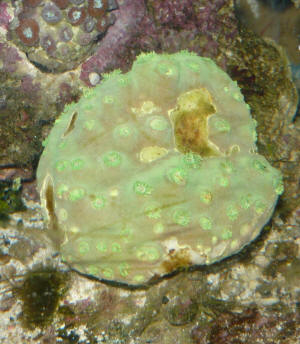 |
|
Re: dying pagoda coral...i don't want to lose it
09/09/08 to be honest i have not done any testing on my
water in 2 years, (bad practice, i know, but i have not needed
to, even now this is the only coral with a problem, the one SPS i
keep is also just fine) aside from checking the salinity when i
do a water change. <What is your salinity, temp, pH,
alkalinity...? I honestly can't help you much without this
info.> what confuses me is i also have a purple cup pagoda
living right next to the green and it is just fine. <Hmm...
has this purple one been in the tank longer? Perhaps there is
some negative interaction going on here.> i have never
directly feed it before though i have seen it grab brine shrimp
and food pellets. can i squirt some frozen brine on it?
<Yes... that might help (do turn off the pumps for a bit while
you do this). Just be careful to also keep your water clean.
Best, Sara M.>
Re: dying pagoda coral...i don't want to lose it
09/10/08 i have had the green for 3 years, the purple
for 8 months. i separated them just in case. only a tiny bit of
tissue has receded since last night i have no testing supplies...
<Not even a hydrometer or refractometer? ...how do you do
water changes? I'm sorry to nag, but you're really asking
for trouble here. In well established tanks, you probably
don't have to measure nitrates/nitrites/etc. But you still
need to at least measure salinity, temp, pH, alkalinity and
calcium.> but are there any pests or disease that can harm
them? anything not related to water conditions? <They are not
known to have pest problems. They often suffer from poor water
quality, starvation, negative interaction with other corals, etc.
Repeating herself, Sara M.> <<Sara... send back to fix
English, search... RMF>>
|
Pagoda cup not polyping? -07/08/08 I have a
Pagoda Cup that I have had in my tank for about 4 months. At first
when I introduced it to the aquarium, it used to fully polyp out
and it looked wonderful. After about 2 weeks, it suddenly stopped
polyping and has not fully polyped ever since. It tries to
sometimes but doesn't come out like it should. I have seen no
deterioration of the cup or any signs of it failing. It still
occasionally removes it's top layer of slime, which I heard is
normal of this coral, to remove anything that might be caught on
the surface. I've tried it in all condition...high light, low
light, medium light...strong current, moderate current...even with
the wavemaker tried to aim a single MaxiJet at it for a 16 second
burst off a natural wave wavemaker. <Uh... maybe too much
changing/moving around. They take some time to "settle
in." Keep it under moderate flow and lighting (light target
feeding also helps a lot).> I feel water chemistry is not the
problem, the tank has been running for 1.5 years, parameters are
stable, <What are these parameters? what are the numbers?>
been able to successfully keep RBTA and clam, along with SPS
corals. All corals experience growth and polyp, this is the only
coral I seem to be having a problem with. Does not change its
patterns of polyping between day and night, stays the same way.
Attached I have a picture of where it is right now, and of it
trying to polyp. This is the furthest I have seen the polyps come
out in about a 2 months. <Yikes> I'm surprised when they
say this one is easy to care for, <It is if you know how. Please
stop moving it around, just be patient.> it has given me the
most grief. I've tried shooting mysis and plankton at it with
the powerheads off, trying to entice it to eat. It used to eat when
I first got it and the when the polyps extended. I've tried
smaller foods such as Cyclops too. Haven't tried phytoplankton
or zooplankton. I've read the articles on this coral in your
forums, can't find any answers. Was wondering if you have had
any personal experience with this happening and/or any solutions.
<Yes, I have had a few of these corals. At least two of mine did
this (though not quite so severely). They recovered/expanded again
in time. Again, please be patient, let the animal get settled. Do
keep feeding it, keep your water quality high, etc.> I've
tried to be as specific as possible with my description to help you
out. Thanks <Best,
Sara M.> |
|
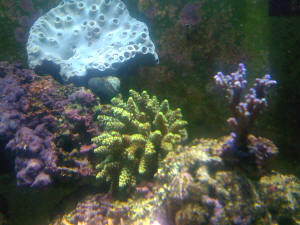
|
| Duncan Disease? Patience, reading 3/9/08 I
recently (yesterday) bought a Duncan colony and when it arrived
today I noticed extreme tissue loss. In the first picture below I
think the loss is from someone trying to frag the coral. But on the
next two pictures you will see the trouble area. This is not my
first Duncan (my second) and in comparing the two my original
Duncan stalk is a bright green. The new colony has some bright
green stalks the further you get away from the tissue loss area.
Also, in the last picture (number 99) you should be able to see
yellow specs on the dying tissue (tissue that is losing the bright
green color). Is this a disease? <Mmm, more likely physical
damage> Will the entire colony die or tissue loss spread?
<Maybe, perhaps not...> Should I try to frag off what looks
to be good? <... I would not... just yet... stick the colony in
your acclimation/receiving system for a week or two...> How do
you frag such a hard coral? Should I keep this in quarantine?
<... Patience, reading... Bob Fenner> |
|
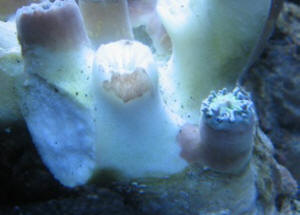
|
Potential problem with Tigertail
Cuke, and Dendrophylliid hlth. 2/10/08 Hi crew- <Jim> I have
a very healthy 75g reef tank with a 20g sump and 10g refugium. This
morning, I noticed something odd - my 6-ish inch long Tigertail Cuke
was scaling the wall of my aquarium - never seen THAT happen before! He
has been in this system for a few years, and reproduced (by splitting)
once a while ago (I pulled out his buddy). My wife noticed a white gash
or laceration running down his body, at least several inches long. We
did the smart thing and pulled him immediately from the tank.
Suggestions? <Mmm, isolate... oh, I see below...> I don't
have an isolated system to put him in so that he can heal up. Am I
better off without him in a system this size at any rate?
<Well...> Should I euthanize him or take him to a LFS? <The
last> I presume that the one thing I should NOT do is to put him
back into my system. <Not necessarily... life IS risk... some minor
sub-risks are to be weighed, chosen...> All other inhabitants of the
system are FINE. Here is what the system looks like:
http://picasaweb.google.com/javagiant/Reef12808 <Wow, quite a mix...
Soft and hard corals, other cnidarians, including an anemone... an
apparently healthy powder blue tang...> While I am writing, I do
have a recent addition (the Turbinaria) <I see this... on the
right> that I could swear is shrinking a little. Color is great and
polyps are well extended. I did some research, and have begun spot
feeding. Will that do it, or does he need more light? <May need to
be moved further from the Actinarian... see WWM re compatibility...
Otherwise, just patience> I have 2 x 175mh and 2 4' actinic VHO
tubes running on this system. Should I move him up, so he gets more
light? <I would not> I have been keeping him debris free -
anything else I should be doing? many thanks- Jim Gray <From the
sparkling looks of your system, obvious health of your livestock...
Running a public aquarium or helping at an LFS. Thank you for sharing.
Bob Fenner>
|
Unidentified items in nano - one is algae, Lobophora variegata
10/08/07 Dear Friend, <Happy Monday> Can you please
help me in identifying something I have in my nano. My tank
parameters are Nitrates 10ppm CA seems to be ok as coralline is
growing well. Phosphates - undetectable but I see a BIT of red
slime algae. It does not grow much but diminishes very slowly. SG
.25 <I think you mean 1.025, right? I hope!> Lights are 1
Phillips 36 w PL and one Philips 20W TL05 on for 10 and 12 hours
respectively. Temp is 26 to 27 C Circulation is 20X tank
deflected off the tank back wall. Skimmer (air-stone driven) is
on 24/7 There are some photos of 2 items attached to this mail.
Sorry but the quality of the image is not very clear :( I seem to
have some saucer like algae? Is this Coralline or some sort of
macro algae? <It looks like Lobophora variegata. Please see
here: http://www.wetwebmedia.com/brnalgae.htm> It grows like
saucers on the live rock. Feels like a thin sheet of plastic
would (approx). It looks like there are some strands of sorts
under this. Remember when you cut okra (vegetable)? You might
have seen similar strands at the cut areas. I touched it
(strands) and it did not come off I think it is coralline because
I can see some similar red growths also on other rocks. <This
could be something else.> It is coralline or a form of macro
algae? <It's algae. And my guess would be Lobophora
variegata. See here too:
http://www.coralreefnetwork.com/marlife/stepath/phaeophyta.html>
The other one is a photo of a coral. It is 2.5 to 3 inches in
diameter and peach/creamy in color. <I'm sorry but the
photo is too blurry for me to guess at what kind of coral you
have here.> The polyps have florescent yellow centers Is this
a cup coral? If so which genus? This coral used to have 13
polyps. I feed it with red sea vitamin soaked krill and marine
fish pieces. I make sure the pieces are small enough to fit in
the oral cavity before I place them on each individual polyp. For
some time it was good and I even saw 3 new polyps sprout. Then
all of a sudden it stopped opening up. I had fed a krill with
some bit of the Chiton intact. Is that a problem? I had read in
WWM that it is good protein and is good for the corals. <Yes,
chopped krill is a good food. But I'd be able to help you
more if I knew what kind of coral this is. If you can, please
send a clearer photo.> This coral is fantastically hardy as it
has survived many calamities before. Once it went through 32 deg
C for a few weeks at a length. <Sounds like a Turbinaria.>
I never ever fed it till I read an article at WWM on LPS. Then I
started to feed 2 times a week. <excellent> I don't
understand why all of a sudden it stopped opening its polyps :( I
did have an anemone. But this was like overnight change. To night
it eats well and tomorrow is stops opening. All other inhabitants
are fine. <Hmmm... strange. How long has it been closed up?
Sometimes corals close up for awhile but come back in a few
days.> I have removed the anemone and given it away.
<good> I have also changed it to lower light levels for a
few days. Did not find any change so kept it back in the original
place. <I doubt light is the issue here.> Any idea how to
get things back to normal? <It's hard for me to say right
now without being sure of what coral this is. If you can send a
better picture or get a better ID, I can help you more.>
Please help :( Ranjith <Best, Sara M.>
Re: unidentified items in nano.
Turbinaria health -- 10/09/07 Hi Sara, Yes. I checked with
some online photos and it seems to be Turbinaria. The peltata
group I believe? So what do you think is the problem? Why is it
not opening up fully? <It could have been freaked out by the
temperature spike (maybe even damaged a little). It could be
recovering from something of a coral version of a "heat
stroke." It's hard to say for sure, but as long as the
tissue isn't receding, it's probably ok.> I do see the
polyps below the opening and the florescent color. Just that it
is not coming out of the shell. You are also correct regarding
the SG being 1.025. <Try target feeding it. Sometimes food can
encourage these corals to start coming out more.> It has been
closed now for 2 weeks. Also why did you guess it is Turbinaria
when I mentioned it survived 32 degrees C? <Because these
corals tend to be tougher than some of the other similar looking
ones.> Cheers and thanks again Ranjith <Good luck,
Sara>
Re: unidentified items in nano -- 10/09/07
Hi Sara The heat wave happened 6 months ago. It was fine till 2
weeks ago. Does not look like a heat wave thing to me. <Oh,
I'm sorry. I misunderstood the time frame.> I tried
placing its favorite krill on it and it couldn't care less
Didn't react. But maybe since it was inside the opening the
meat didn't touch it? <What do you mean "inside the
opening?" One remote possibility is that the plating
macroalgae you sent me pictures of in the first email is
secreting something that is upsetting the coral. In nano tanks,
chemical warfare can be a real problem. Maybe you should try
removing that algae and running some new activated carbon.>
Cheers and thanks again
Ranjith
<Best,
Sara M.>
|
|
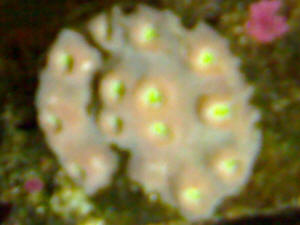 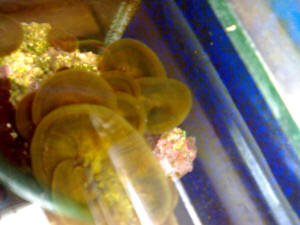
|
My Green Pagoda Coral Isn't 'Green'
-- 07/09/07 I bought a green pagoda from a LFS but it was all cream
colored. <<The 'cream' color in not uncommon for this
Turbinaria species>> The salesperson told me the color would come
back to green with yellow polyps but it has not. Is there anything I
can do to get it to color up or is it lost forever? <<If this
specimen was indeed 'green' to begin with, the color change may
be due to collection/transport stresses, a reaction to the change in
intensity and quality of lighting from its collection point...or just
the difference in water chemistry/environmental conditions period.
It's hard to say if the color change is permanent...provide the
coral with optimum conditions and time will tell. EricR>>
Thanks.
Black Spot On Sun Coral (Tubastraea), no useful
data 6/22/07 Hi. I have a sun coral that I bought approximately 6
weeks ago. Today, I noticed that there is a small (approx 2mm in
diameter), circular black spot on one of the larger cups. Otherwise,
the coral seems happy and healthy, and none of the other cups (or
corals in the tank) appear to be affected. I would be very grateful if
you could advise me as to whether this is something to worry about -
and, if so, what steps I could take to ameliorate the problem. Thanks
very much in advance. Lindsey. <Mmm, could be of concern... no
useful info. re the set-up, maint., water quality tests... you are
making sure each polyp is getting fed? Is this specimen near more
strongly stinging, more noxiously exudating species? Have you read
here: http://www.wetwebmedia.com/dendrodisfaqs.htm and the linked files
above? Bob Fenner>
Re: Black Spot On Sun Coral (Tubastraea)
6/23/07 Hi Bob: Thank you for your response! My tank is very new
(about 3 months) and is 55 gallons. I have a protein skimmer and
trickle filtration. My ammonia tests at nil, phosphates undetectable,
alkalinity at 12.8 (I know that's on the high end, but my PH is
8.2, so that's not a problem, right?), <No, not likely>
calcium is 360, salinity at 1.025. There is a frogspawn coral to the
right of the sun coral - <... trouble> I thought there was enough
separation between the two, <Needs to be a foot or more... and even
then, chemically...> but the affected cup is on the left hand side -
which is closest to the frogspawn - and is, as I mentioned, one of the
larger cups and would definitely reach in that direction when fully
extended so perhaps it has been stung? <Yes> I checked again this
morning and the spot has not enlarged at all and is still affecting
that specific cup only, so I have moved the frogspawn over to the right
a little. I do feed each cup at least 5 times a week with Mysis shrimp.
<Good> The other occupants of the tank (aside from corals) are: 2
Anthias, one clown tang (small), <Needs more room...> cleaner
shrimp, fire shrimp and 2 clowns. If you have any other suggestions I
would really appreciate them as I am just starting out in this hobby
and I love your site! Thanks again, Lindsey. <Mmm, do see WWM re the
Tubastraea and Euphyllia...
http://www.wetwebmedia.com/marine/inverts/index.htm Bob
Fenner>
|
Cup coral tissue loss and bleaching
5/22/07 Hi, <John> I took a normal
inspection of the tank occupants on Saturday morning and noticed
that my pagoda cup coral (Turbinaria) had a large area of white/
bleached tissue accompanied by some tissue loss in that area, in
which I saw tissue flaking off and exposed skeleton. I examined
it again today to find that the area of tissue loss is expanding
in that area. Also the polyps in this bleached area are shrunken,
white, and look sickly. <Mmm, looks like an "impact
zone" injury...> There are no sweeper tentacles around
that could affect this coral. The display tank has a volume of 30
gallons, and the sump holds 10 gallons. Bio filtration is
accomplished with a wet dry filter, Bak pak skimmer, and # 30
live rock. Reef crystals salt is used and reverse osmosis/
deionized water is always used. water circulation is provided by
3 maxi jet 1200 powerheads. The affected coral is in nice flow
and the lighting is 130 watt 50/50 power compacts. nitrate
readings are under 5. Nothing has changed up to this point and
all other corals are doing fine. I am very concerned as this is a
nice piece which I have had for two years in this system without
any problems. I have attached a photo of the affected area.
Thanks for your help. <Does look to me like something
"dropped onto" this area... do you dose something that
may have centered itself about in such a pattern? Bob
Fenner>
|
|

|
|
Re: Cup coral tissue loss and
bleaching 5/22/07 Thanks so much for the
reply Bob. I do not dose anything to the tank. However, When I
noticed this problem in the coral, I added a normal dosage of
Kent coral vital general supplement. <Mmm... I would
"test" this by applying a bit more to another area of
this coral... I am not a fan of such "general"
tonics...> to the sump. So the root of the problem does not
lie with dosing to my knowledge. The only thing I can think of is
maybe salt creep that fell into the water landed onto this coral,
which seems unlikely, but still possible. <Yes... and a rather
common cause of such "burns"> Today, the area of
tissue loss /exposed skeleton has increased slightly. The tissue
necrosis is moving toward the bleached area, not onto healthy
colorful tissue, which is good (I hope!) <Yes... and again,
indicative of some "one-time" impact...> I don't
know if I should take any action. I am going to change the water
now and Ill make sure no crud builds up and the infected area
stays clean in the mean time. Thanks for the help Bob. <I
agree with your cautious approach... I would do nothing overt
here. Cheers, BobF>
|
|
Re: Cup coral tissue loss and
bleaching 5/22/07 Hi again Bob and again you
don't know how much I appreciate your help. <Welcome>
People on the forums are telling me to cut the entire side of
this coral off with a power saw....... What do you think of this?
<I would NOT do this... too extreme at this venture... have
seen much worse damaged Dendrophylliids make full
recoveries...> I will do nothing at this point but at what
point would you think it would be necessary to take action?
<Do take a read re the family on WWM... RMF>
|
Orange Sun Coral - 03/23/07 Hi! <<Hello!>>
I recently acquired an orange Sun Coral which the LFS near my home had
not been having too much luck with. <<Not unusual...generally
requires special attention/some direct feeding to prosper>> I
placed it in a tunnel out of direct light and offered it food (live
baby brine shrimp, Mysis shrimp, Microvert, Marine Snow etc.) every
evening after the lights were off. <<The variety of food is good
(though feeding well every 2-3 days may be enough), but placing out of
direct light is not always necessary. Tubastrea species are sometimes
found on the "lighted" side of the reef (I have two colonies
exposed to direct lighting), though Dendrophylliid species are most
often in "shaded" positions. What is most important is that
these corals receive very good water flow>> It did appear to be
eating. Here is my problem and resultant question. About 3 days ago I
noticed that the majority of the polyps had been covered with orange
colored "bubbles" causing the Tubastrea to resemble Bubble
Coral. <<Mmm, haven't ever witnessed this...but doesn't
sound good to me>> The few remaining normal appearing polyps
traveled off its original rock and have attached themselves to the side
of the tunnel. <<Ahh...what you may have is a Dendrophyllia
species and not a Tubastrea species. In my experience, Tubastrea have
connective tissue between the polyps that would prevent individual
polyps from "relocating"...Dendrophyllia, again in my
experience, does not have this connective tissue and looks like a bunch
of polyps "glued" to a rock. Admittedly these are subjective
observations and an examination of the coral's skeleton is likely
required for a positive ID>> What are the "bubbles" on
the once beautifully tentacled Sun Coral? <<Hmm...possibly a
bacterial infection or encroachment of Cyanobacteria. Difficult to say
really, but very likely a symptom of its environment. Or maybe it was
just "too far gone" when you acquired it>> Any
assistance/information you can give me will be greatly appreciated as I
am truly in a quandary about this. <<Do ensure the coral is
receiving plenty of vigorous water flow. If this doesn't clear up
the "bubbles", you may want to consider a mild iodine
dip/bath, but some corals may not respond well to these...do read here
and among the associated links: http://www.wetwebmedia.com/dips_baths.htm>> Many
thanks, Gigi <<Happy to share, EricR>>
Feed me Seymore: Starving Tubastraea
12/16/06 Hi guys and gals! <Hello there Lisa, Mich
here.> Once again, thank you for taking the time to review and
respond to my question. I always appreciate it. <You are quite
welcome. The pleasure is mine.> I've had this coral for
about a month now. I was told it was a fire coral. <Mmm,
nope.> But it doesn't look like any of the fire corals
I've seen, and it doesn't seem to sting. <Mmm, because
it's not.> I'm also not sure it's doing well.
<Doesn't look real happy.> It doesn't seem to change
much but I've noticed one of the corals seems to be receding.
<Yes, that appears to be the case.> Since I can't really
identify it, I'm not sure of it's flow, lighting and
feeding needs. <Best to educate yourself before assuming
responsibility for any living creature.> I'm hoping you
experts will know and will tell me what I need to do. <This is a
coral in the genus Tubastraea, commonly called a sun coral. It is
non-photosynthetic, meaning that it cannot get any of its'
energy requirements from the sun or artificial lighting. Kind of
ironic that it is called a sun coral. It must be feed regularly by
it's caretaker. Mysid shrimp soaked in a vitamin supplement
such as Selcon would be ideal. The feeding should be done after the
tank lights go off. It may take several days of attempted feedings
before the polyps open, especially in this situation where there is
this much tissue recession. Eventually it will automatically extend
its' polyps when the lights go out in anticipation of its'
next meal. It should be placed in an area where it receives good
water flow. It can be placed in a well lit area, but doesn't
need to be as long as the water flow is decent. It is a beautiful
coral, but will need some dedication on your part to bring it back
to health. Thanks,
<You're welcome. -Mich>
Lisa |
| Re: Feed me Seymore: Starving Tubastraea
12/16/06 Hi again THANK YOU SO MUCH for your reply.
<Hello Lisa, Mich here again. You are quite welcome.> If this
coral does not depend on the light, I assume it's location in
the tank (currently high up nearer to the light) is <not?> as
important? <This coral will not benefit or be harmed by any
light it receives. It does require good water movement.> Can
this coral be placed on the substrate? <Certainly.> Do I need
to use a dome to feed it? <No. Turn off you circulation and use
a turkey baster to gently blow the Mysid over the polyps, with
time, the polyps will open and a Pavlovian conditioned response
should develop, especially if you do this consistently after lights
go out.> Thanks again, <Welcome -Mich> Lisa Your
edification: http://www.wetwebmedia.com/dendrophylliidae.htm |
|

|
| Coral polyp anomaly? 6/14/06 Saw this picture but I
can't find the related article. Had this happen to my coral but
it went away weeks later and is doing fine since. <Looks to be
an enlarged polyp in your Turbinaria... happens... irritation of
some sort.... a mechanism for expulsion. Bob Fenner> Nicholas
Parenti |
|
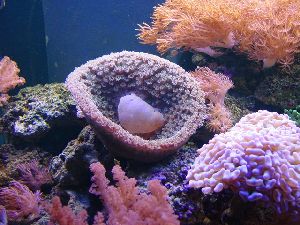
|
Purple/ blue skeleton (Turbinaria reniformis) -
04/27/06 Hi Bob/ Staff I got a huge cup coral today with a purple/
blue skeleton (Turbinaria reniformis). <... have never seen a
Turbinaria with such a color skeleton... are brownish to yellowish with
light green highlight. Your might have been dyed> Info on these
babies are pretty scarce/ am suspecting there not to popular. But
anyway, It is producing a huge amount of slime and the polyps are
closed. Why is it producing and excreting such large amounts of slime.
<From handling, being moved, reaction to other cnidarians?> 2nd,
The white polyps are closed, do they only open @ certain times?
<Yes... when the animal/colony is established, healthy, feeding.
Please see WWM re Dendrophylliids. Bob Fenner> Thanks for your time.
John
Re: Purple/ blue skeleton (Turbinaria reniformis)
4/27/06 thanks for the reply Bob. <Bob is at a conference, Jen
S. here.> I must have spoken too soon because the coral opened up
beautifully today. <Wonderful!> And I was a bit inaccurate with
the description of its coloration, its actually a yellowish bluish
green. Anyway, I tested Nitrates today and they were about 25 PPM.
<Too high> Is this a dangerous for the cup coral or my yellow
polyps? <Absolutely. Do a 20% water change, clean up any detritus,
replace filter media, clean skimmer'¦ so on.> I will look
on WWM in the mean time to find ways to lower the nitrates. Thanks
again, <Good deal. Have a great night, Jen S.> Mr.
John
Re: Purple/ blue skeleton (Turbinaria reniformis)
4/30/06 to Jen S. I did a big water change and reduced them to
about 10 - 15 mg/ l. can I repeat water changes tomorrow to lower them
more? thanks <I wouldn't change too much too quickly. Every
other day would be good. Jen S.>
| Turbinaria peltata Dear Bob and Crew,
<Keep waiting for one of our reef-types to chime in...
hello!> I need assistance please. I have had a Turbinaria
peltata in my 50 gallon tank since August of 04. I have noticed in
the last couple of month some of the tissue starting to recede.
Parameters are as follows: 50 Gallon Flat Back Hex Ammonia - 0,
Nitrate - 0, Nitrite - 0, Phosphate - 0. Calcium 300/350 - Alk High
on my Red Sea Test Kit <High?> Approximately 125 lb Texas
Holey Rock almost completely covered with Coralline Algae. <...
some of this rock is unsuitable for marine aquarium use> 1 -
Yellow Tang approximately 3.5 inches long. 1 - Coral Beauty
approximately 3.0 inches long. 1 - Lawnmower Blenny approximately
3.0 inches long. Assortment of Mushrooms and Button Polyps. I have
a 300 gal/hr powerhead on lower right corner. I have a HOT Magnum
200 gal/hr in the middle upper right side. Emperor 400 on the left
side just behind the T. peltata. I set a container of Kalk on top
of this and drip it through the perforations in the top of this
unit for make-up water. Could this be a problem? <Mmm, don't
think so...> Lighting was 100 watts of 20K NO Light. I upgraded
to Coralife 260 Watt Unit consisting of 130 watts of 10K and 130
watts of Actinics. This unit was purchased this past weekend. You
can see from the picture that the coral is only 4" from the
light source. <Yes> I target feed this coral with a
combination of Mysis shrimp, Ocean Nutrition two to three times per
week. It readily accepts what I feed it. I also dose 30 ml of
DT's per week. This is mainly for my feather duster and
gorgonian. Your thoughts please, I don't want to lose this
coral. Thanks Dean <Likely the animal/colony is just adjusting
to the new lighting... but am concerned re the "high"
alkalinity... Put yourself in our place here... how high is
high?... you don't want any more than 12-15 dKH... I would be
checking the holey rock as a source of excess alkalinity... and
either moving deeper light sensitive life when switching to more
intense lighting, or partially shielding the lamps for a few
weeks... when they're new or replaced. Bob Fenner> |
|

|
Turbinaria "Cup Coral" Dear Bob: Happy
holidays to you and your family. <And to you and yours> I have
e-mailed you within the last few months regarding my 92 gallon reef
tank that has had a horrible hair algae problem. You indicated that my
tank was probably "off center" and to be patient, maybe
introducing a Lawnmower Blenny or Tang. I have not introduced any of
these new fish yet, but I did recently convert my sand bed to a deep
sand bed (brushed all rock in a separate container during this
process). I also performed about a 25% water change during this
changeover. Everything looks great now, and I hope this will persist.
<Ah, good> My question to you now regards my Turbinaria cup
coral. During the last few months when my tank was creating the hair
algae disaster, this coral stopped extending it's polyps. The coral
was not dead, as on a couple of occasions it did spew out some black
film. Since I had this coral high up in my VHO lit tank and did replace
my lamps around the time the polyps stopped extending, I thought it may
be unhappy due to the light intensity change instead of water
chemistry. <Both... perhaps more of the latter> When I performed
by sand bed change a week ago, I decided to place this coral more in
the middle of the tank. However, still, the polyps do not extend (not
even at night). Since the polyps have now not extended for about 3
months, do you think it is dead? Do you think there is any hope? The
coral has not changed color. <You will know, by sight, smell if/when
this animal has perished... do try feeding it. Please read here:
http://www.wetwebmedia.com/dendrophylliidae.htm the FAQs beyond. Bob
Fenner> Thank you. John Rowe
Re: Turbinaria "Cup Coral" Thanks, Bob. I
should have read your section before e-mailing. <Do wish there was a
scheme for more easily making WWM available, accessible> I have the
Turbinaria peltata coral, and I'll try the feeding recommendation.
I do feed the tank with live phytoplankton, but apparently this is not
enough. Unfortunately, my LFS did not inform me of the need to feed.
<Ah> Thanks again. <Be chatting my friend. Bob Fenner>
John
Re: help me cup coral 10/3/05 All apologies,
this was typed up real fast on my way to our weekend house. I have a 12
gallon Nano cube pushing about 5 watts per gal. Would it be better
suited in there? <Be better than where it was. Problem with keeping
SPS's in small systems is that water parameters can change too
fast.> When I returned on Sunday, the polyps were closer to coming
out. I originally went to the LFS for a Monti cap but was steered
toward the cup coral because of the lighting, but we know how that
goes. <Your 5 watts/gallon needs to have some actinic light if you
don't already have it. James (Salty Dog)>
Cup coral 10/3/05 It does have actinics. Should I
transfer it now while it still isn't open? Or is it too stressful
to do that? <Can't get any worse than what it is. Try it. Keep
in mind that these corals are not the easiest in the world to keep.
Have you been adding iodine, strontium, etc to the tank and doing
weekly 10% water changes? James (Salty Dog)>
Re: Cup coral 10/4/05 I know that now but...yes I keep
up w/ the water changes. There isn't anything in that tank but a
hammer coral, a few zoo's and a few Ricordea. If I have to I can
upgrade the lights to a 96x2 watt. Still not what your suggesting but
better. I was told the "watts per gal." rule didn't apply
because power compacts were far better than fluorescents just like MH
are to PC and thus cannot be compared. <The watts/gallon is a
starting point keeping in mind that too much light is certainly not
detrimental. You have to understand also that yes, the PC's have
more light output, but the watts/gallon guideline is based on
VHO/HQI/MH/PC. The depth of the tank would be a factor in deciding if
more or less light is needed. James (Salty Dog)>
Turbinaria Mr. Fenner My Turbinaria (peltata?)
don't open the polyps. After one or two weeks in my aquarium in the
upper part under a powerhead the coral don't show signs of stay
alive. Do you have some advice? Thanks, Nelson <Hmm, a few
possibilities here. Please read through our coverage of the family:
http://wetwebmedia.com/dendrophylliidae.htm the associated FAQs page,
The large polyp stony corals, stony corals, and associated FAQs
pages... and we'll chat further. Bob Fenner>
Turbinaria problem I have a cup coral that stated to
lose some of its polyps in one area. In their place is a hole with two
slender antennae protruding. It's happened over the course of a
week and started with one and now has 9 or so missing. Most of the
empty holes show antennae. I 've checked at night with a flashlight
but have never seen any worms on the coral head. Any ideas or
suggestions? It's a lovely piece and I don't want to lose it.
Many thanks-- Dean Decker <Hmm, you might not have much choice
here... does sound like some marauding species of boring (as in
drilling, not yawning) of Polychaete worm (maybe with some accomplices)
have taken up residence in your Dendrophylliid... I would just
"hand on and hope" at this point... Very unlikely that a
predator (like a Pseudocheilinus sp. Wrasse) would/could clear them
out... this or a Stenopid, Palaemonid shrimp might help though... worth
a try. Please read: http://wetwebmedia.com/dendrophylliidae.htm
http://wetwebmedia.com/bristlewrmfaqs.htm
http://wetwebmedia.com/shrimp.htm
http://wetwebmedia.com/pseudocheilinus.htm Bob Fenner>
TURBINARIA DAMAGE??? Hey Bob, Just purchased a yellow
Turbinaria the other day and my wall hammer welcomed it with a long
sweeper tentacle. Well a few days later after moving the hammer well
out of reach (unbelievable what a reach it has) I am noticing a small
grey black decaying patch on my Turbinaria. Question is what to do
remove damage via Exacto knife or leave it alone??? Thanks again Rob
Huss <Hmm, I would leave this colony be at this point... generally
will regenerate. Bob Fenner>
Help - Cup coral 1st of all, this is the best BB I have
ever encountered. Your help is priceless. Now that the smooching is
over, let me get to the problem at hand. I have a cup coral (Turbinaria
peltata...I think...maybe pagoda) I enclosed a picture just in case. I
have had it for a year, but recently, it is having troubles. The polyps
do not extend at all. It was doing fine under a 55 watt PC. Now, that I
have added an additional 55w Actinic, is hasn't opened. I do not
recall if the light addition & polyp shyness happened at the same
time or not. Regardless, it has been 1-2 months, and still no change. I
am afraid that I might lose my favorite coral. I must add, that
throughout the 1st year, I did not add a supplement to the tank such as
Coralvite, Essential Elements, etc. I merely fed the coral just as I
fed my 2 clowns. Nitrates, Nitrites, PH, all good. Calcium a little
low. Should I of added Strontium? Please tell me the appropriate manner
in which to care for these corals, as I am afraid that I have failed.
<It appears that you doubled your lighting and shocked your coral.
This is a very unnatural thing to occur, but you are lucky because
Turbinarias are very resilient. Since you only gave general references
to water quality, here is what your coral needs; a pH above 8.2,
Calcium above 400 ppm, fed 2-3 times per week with something small like
Sweetwater Zooplankton or Mysis Shrimp, and it may benefit from some
iodine. I do not use or recommend most of the magical elixirs for reef
tanks. I follow the Fennerism, if you cannot test for it, do not dose
for it. -Steven Pro>
Fading pagoda I have a yellow pagoda coral, sorry no
pic. <There are two main types of "pagoda" coral:
Turbinaria reniformis and t. peltata. T. reniformis is commonly yellow
in color, has a thin but dense skeleton, and grows in a turbinate form
(whorling plates). T. peltata usually only forms a single cup shape but
can also have a few "whorls". The skeleton is thicker than
that of the former and has big bushy polyps. T. peltata does not have a
yellow color morph, so if you have this species, it's most
definitely dyed.> I have a it about a week or so. all my levels are
right where there supposed to be. its at mid tank in my 55g. I have a
HQ1 150Wx1 MH. its seems to be fading fast on one side of it.
doesn't seem to be dyed, the other side of it is keeping its vivid
color. <Sounds like the halide is bleaching it. Put it off to the
side in low, indirect light for now until it regains it's color.
Only then should you try to begin the slow process of acclimating it to
your lighting> it does have die off on the outer edges of it though,
from when I bought it. any info would be great on what you would try in
this situation. <Eh, I wouldn't worry about the dead spots
unless some algae got a foothold and started encroaching on the living
tissue. Good luck! -Kevin- > Thanks, IRV
Turbinaria care 9/15/04 Hi recently purchased a
Turbinaria peltata, turban, platter saucer coral, it was in good shape
3 days ago, now, right in the middle it looks to be dying it has a
brown spot with stringy stuff coming out, <could just be
digestion... no worries just yet> what can I do for it my water is
in good shape, everything except my nitrates are at 20 which I have
done a water change 25 percent I will test water again, is there
anything I can dip the coral in to help it, I am running power
compacts, so I don't think this is a problem, my tank has been up
and going for months now, everything else fish and other corals are ok,
no corals close to it WHERE SHOULD I PLACE THIS CORAL RIGHT NOW IT IS
SITTING ON A ROCK IS THIS OK??? I HAVE 125 GALLON AQUARIUM, THANKS
<this coral is highly adaptable... please do have patience my
friend. Share a pic when/if you can for better ID of the problem.
Anthony>
Turbinaria and algae. Hello Again Crew << Hi
there, Blundell here. >> You helped me out once before so I will
call on you once again. I have a pagoda coral I believe it is
Turbinaria peltata that I inherited from a friends aquarium when he
left the hobby. When I received it, it was not extending its polyps but
since has come to fully extend and feed once again. The problem is
there is a patch in the center of the coral that has died and Green
hair algae has a foot hold. My water conditions are relatively good
with my only concern being my nitrates somewhere between 10 and 20 ppm.
I have managed to win my battle with hair algae in most places except
on this coral. The algae seems to do much better in this location than
any other even though circulation is good. I have tried to clean it of
with a toothbrush but I am worried about damaging the coral. Other that
trying to keep my nutrient export up, feed lots and keep water
conditions good is there anything that I can do? << Hermits and
snails. Also, it isn't such a bad thing, so I don't know if
I'd get worked up about it. >> Also is this species of coral
completely non photosynthetic? << I have a difficult time
believing so. Calfo may say otherwise, but their color changing
responses to lighting conditions give me reason to believe they are
photosynthetic. >> Lonnie Chin << Blundell
>>
Tubastrea (sun polyps) losing color
- 2/17/05 Hello Crew! <Hey Elmer> I must say that I'm an
avid reader of your web site, learning a lot of things. <Great! Me
too, actually> Thanks for that. <Thanks for coming here and being
part of it all. It is why we do what we do> I have a beautiful
sun/tube coral (Tubastrea aurea) which is in my aquarium for about 3
months now. <Fed well I hope?> I noticed that it started to lose
its orange color at the base of its tubes. <Fading or actually
turning colors?> It started as one spot three weeks ago that is
gradually enlarging through time. <Hmmmm> Now, most of the bases
and in between the tubes are grayish in color. <How is the flow
around this coral??> Is this a sign of a dying coral? <Very
possible. How do you feed this coral? This is a non-photosynthetic
coral so it will need feeding somewhat frequently. At least every three
to five days> It is sitting at the bottom of my aquarium, not in a
shaded area. <Not necessarily an issue but I have usually spotted
these corals growing caves and overhangs usually upside down> My
water parameters are very good. <OK Be sure to check it and maybe
even have someone check if possible. Maybe a local fish store?> I
have a 50g aquarium (5 months old), 192w fluorescent lighting, Arctica
chiller maintained at 77F, 60lbs live rock, CPR Cyclone CY 194
sump/skimmer/filtration system with carbon, RowaPhos, and BioBale
inside. <You can take out the BioBale if you would like, otherwise
sounds very nice> I have a flame angel, yellow tang, 2 damsels, a
Banggai cardinal, 2 soft corals, 2 LPS corals, a starfish, and 2
cleaner shrimps. <Good selection. Keep an eye on the damsels.
Destructo twins for sure> This tube coral is my first coral. It is
beautiful and I earnestly don't want to lose it. <Again, be
aware they like a medium flow and need to be fed regularly as stated
above. Try a mixture of various Mysid, Cyclops-Eeze, baby brine, Omega
one etc and try target feeding if you don't already. Very likely
they do get some food left over from the fish feedings but better to
target. Again, to reiterate, this is not a coral that requires
lighting.> It still continues to expose its yellow tentacles at
night time. <A good time to feed it> Please advise. <I
can't say for sure that this coral is dying, but I think increase
the flow, maybe hang it in an overhang or cave, and target feed when
tentacle are exposed will get the coral back on track.> Many thanks
for your help. <Hopefully I have helped. Remains to be seen. Thanks
for being part of it all. ~Paul> Regards,
Elmer
|
|

